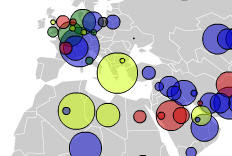Want to Catch the World Cup at your Local Bar? Better Know Which Flag they are Flying
Looking for camaraderie and perhaps quaffing a few brews during the FIFA World Cup matches? You better know which way the local patrons are leaning before sending out a "whoop" and "holler" during a game. Well now the New York Times can help you find just the right establishment with an interactive map that shows you the local allegiances. Jack Dempsey's on West 33rd is obviously a U.S. hang out but Barolo's on West Broadway is going for the Italians. The Time's map shows that Plein Sud, also on West Broadway, has both French and U.S. leanings. Would you like American or French fries with that burger?
